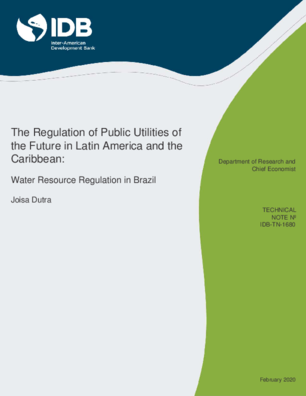The Regulation of Public Utilities of the Future in Latin America and the Caribbean: Water Resource Regulation in Brazil
Date
Feb 2020
While 12% of the world’s freshwater is located in Brazil, its unevenly distributed across the country. As a result, water scarcity is a real and present challenge in many areas across Brazil. Scarcity, in turn, creates conflicts among water multiple users. Climate change will exacerbate water scarcity and associated conflicts.
Existing mechanisms for addressing water scarcity are inefficient in that they do not incentivize the reallocation of water towards its highest value use. The objective of this paper is, therefore, to examine the desirability and feasibility of creating water markets to promote the efficient reallocation of water.
We conduct a first-principles analysis to show that water markets may dominate other instruments, including water pricing (that is, a price above and beyond the cost of storing and transporting water, to reflect water scarcity). There are two key reasons for favoring water markets over water pricing. First, calculating the correct water pricing is not a trivial exercise. In contrast, a well-designed water market will lead to price discovery and efficient outcomes. The second reason is of a political economy nature. By assigning tradable water rights, users can benefit financially from selling water to a higher value user, whereas as a water price is essentially a tax that may not send the correct signal to agents involved.
To assess the feasibility of water markets, we conduct a readiness assessment to identify the main barriers to the creation of water markets in Brazil. Policy recommendations are then provided to overcome the barriers identified in our analysis. For illustration purposes, we simulate the gains from a water market in the São Marcos River Basin, where agriculture and hydroelectricity generation activities compete for the existing water resources. In the scenario where the market regulator imposes a restriction in the use of water that generates an excess demand of 30% with prices set to zero, if a linear rationing system is applied, total loss of welfare would be 30%. However, if a market for water exists and works in a competitive way, we estimate that the total loss of welfare would be only of 2.5%.
Existing mechanisms for addressing water scarcity are inefficient in that they do not incentivize the reallocation of water towards its highest value use. The objective of this paper is, therefore, to examine the desirability and feasibility of creating water markets to promote the efficient reallocation of water.
We conduct a first-principles analysis to show that water markets may dominate other instruments, including water pricing (that is, a price above and beyond the cost of storing and transporting water, to reflect water scarcity). There are two key reasons for favoring water markets over water pricing. First, calculating the correct water pricing is not a trivial exercise. In contrast, a well-designed water market will lead to price discovery and efficient outcomes. The second reason is of a political economy nature. By assigning tradable water rights, users can benefit financially from selling water to a higher value user, whereas as a water price is essentially a tax that may not send the correct signal to agents involved.
To assess the feasibility of water markets, we conduct a readiness assessment to identify the main barriers to the creation of water markets in Brazil. Policy recommendations are then provided to overcome the barriers identified in our analysis. For illustration purposes, we simulate the gains from a water market in the São Marcos River Basin, where agriculture and hydroelectricity generation activities compete for the existing water resources. In the scenario where the market regulator imposes a restriction in the use of water that generates an excess demand of 30% with prices set to zero, if a linear rationing system is applied, total loss of welfare would be 30%. However, if a market for water exists and works in a competitive way, we estimate that the total loss of welfare would be only of 2.5%.




